Ziqi Li
RubikSQL: Lifelong Learning Agentic Knowledge Base as an Industrial NL2SQL System
Aug 25, 2025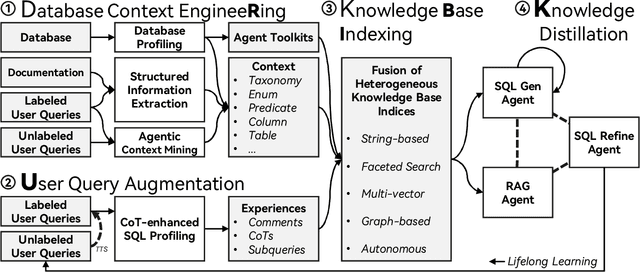
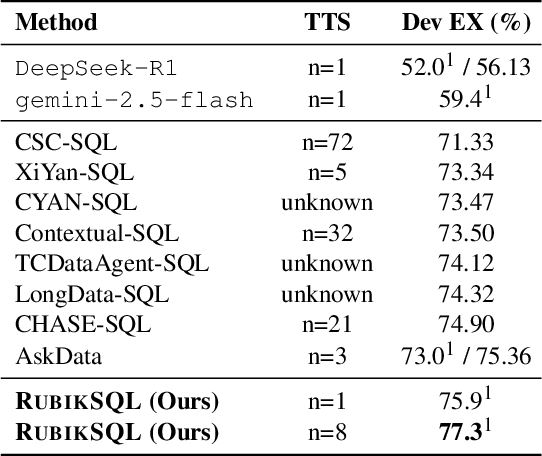
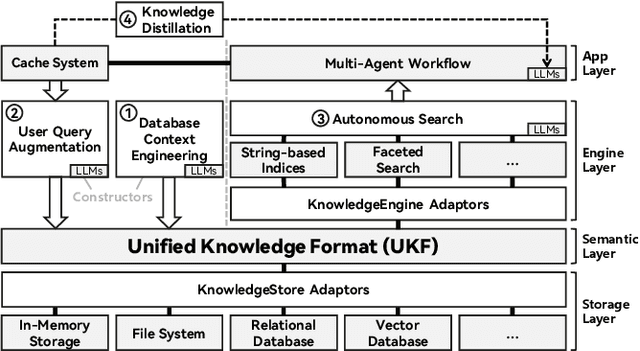
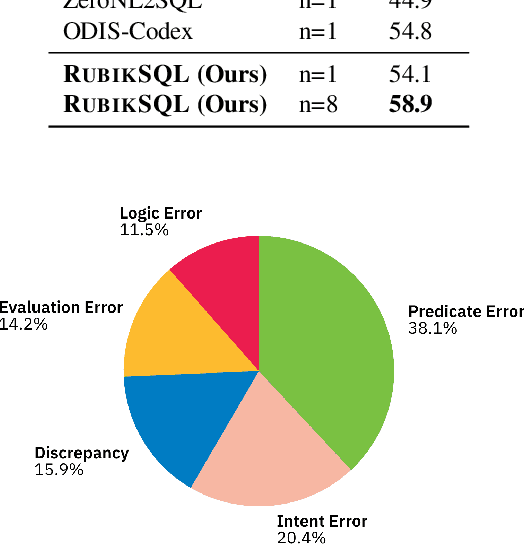
Abstract:We present RubikSQL, a novel NL2SQL system designed to address key challenges in real-world enterprise-level NL2SQL, such as implicit intents and domain-specific terminology. RubikSQL frames NL2SQL as a lifelong learning task, demanding both Knowledge Base (KB) maintenance and SQL generation. RubikSQL systematically builds and refines its KB through techniques including database profiling, structured information extraction, agentic rule mining, and Chain-of-Thought (CoT)-enhanced SQL profiling. RubikSQL then employs a multi-agent workflow to leverage this curated KB, generating accurate SQLs. RubikSQL achieves SOTA performance on both the KaggleDBQA and BIRD Mini-Dev datasets. Finally, we release the RubikBench benchmark, a new benchmark specifically designed to capture vital traits of industrial NL2SQL scenarios, providing a valuable resource for future research.
Improving the Computational Efficiency and Explainability of GeoAggregator
Jul 23, 2025Abstract:Accurate modeling and explaining geospatial tabular data (GTD) are critical for understanding geospatial phenomena and their underlying processes. Recent work has proposed a novel transformer-based deep learning model named GeoAggregator (GA) for this purpose, and has demonstrated that it outperforms other statistical and machine learning approaches. In this short paper, we further improve GA by 1) developing an optimized pipeline that accelerates the dataloading process and streamlines the forward pass of GA to achieve better computational efficiency; and 2) incorporating a model ensembling strategy and a post-hoc model explanation function based on the GeoShapley framework to enhance model explainability. We validate the functionality and efficiency of the proposed strategies by applying the improved GA model to synthetic datasets. Experimental results show that our implementation improves the prediction accuracy and inference speed of GA compared to the original implementation. Moreover, explanation experiments indicate that GA can effectively captures the inherent spatial effects in the designed synthetic dataset. The complete pipeline has been made publicly available for community use (https://github.com/ruid7181/GA-sklearn).
Explainable AI in Spatial Analysis
May 01, 2025Abstract:This chapter discusses the opportunities of eXplainable Artificial Intelligence (XAI) within the realm of spatial analysis. A key objective in spatial analysis is to model spatial relationships and infer spatial processes to generate knowledge from spatial data, which has been largely based on spatial statistical methods. More recently, machine learning offers scalable and flexible approaches that complement traditional methods and has been increasingly applied in spatial data science. Despite its advantages, machine learning is often criticized for being a black box, which limits our understanding of model behavior and output. Recognizing this limitation, XAI has emerged as a pivotal field in AI that provides methods to explain the output of machine learning models to enhance transparency and understanding. These methods are crucial for model diagnosis, bias detection, and ensuring the reliability of results obtained from machine learning models. This chapter introduces key concepts and methods in XAI with a focus on Shapley value-based approaches, which is arguably the most popular XAI method, and their integration with spatial analysis. An empirical example of county-level voting behaviors in the 2020 Presidential election is presented to demonstrate the use of Shapley values and spatial analysis with a comparison to multi-scale geographically weighted regression. The chapter concludes with a discussion on the challenges and limitations of current XAI techniques and proposes new directions.
Can Moran Eigenvectors Improve Machine Learning of Spatial Data? Insights from Synthetic Data Validation
Apr 16, 2025Abstract:Moran Eigenvector Spatial Filtering (ESF) approaches have shown promise in accounting for spatial effects in statistical models. Can this extend to machine learning? This paper examines the effectiveness of using Moran Eigenvectors as additional spatial features in machine learning models. We generate synthetic datasets with known processes involving spatially varying and nonlinear effects across two different geometries. Moran Eigenvectors calculated from different spatial weights matrices, with and without a priori eigenvector selection, are tested. We assess the performance of popular machine learning models, including Random Forests, LightGBM, XGBoost, and TabNet, and benchmark their accuracies in terms of cross-validated R2 values against models that use only coordinates as features. We also extract coefficients and functions from the models using GeoShapley and compare them with the true processes. Results show that machine learning models using only location coordinates achieve better accuracies than eigenvector-based approaches across various experiments and datasets. Furthermore, we discuss that while these findings are relevant for spatial processes that exhibit positive spatial autocorrelation, they do not necessarily apply when modeling network autocorrelation and cases with negative spatial autocorrelation, where Moran Eigenvectors would still be useful.
DistJoin: A Decoupled Join Cardinality Estimator based on Adaptive Neural Predicate Modulation
Mar 12, 2025Abstract:Research on learned cardinality estimation has achieved significant progress in recent years. However, existing methods still face distinct challenges that hinder their practical deployment in production environments. We conceptualize these challenges as the "Trilemma of Cardinality Estimation", where learned cardinality estimation methods struggle to balance generality, accuracy, and updatability. To address these challenges, we introduce DistJoin, a join cardinality estimator based on efficient distribution prediction using multi-autoregressive models. Our contributions are threefold: (1) We propose a method for estimating both equi and non-equi join cardinality by leveraging the conditional probability distributions of individual tables in a decoupled manner. (2) To meet the requirements of efficient training and inference for DistJoin, we develop Adaptive Neural Predicate Modulation (ANPM), a high-throughput conditional probability distribution estimation model. (3) We formally analyze the variance of existing similar methods and demonstrate that such approaches suffer from variance accumulation issues. To mitigate this problem, DistJoin employs a selectivity-based approach rather than a count-based approach to infer join cardinality, effectively reducing variance. In summary, DistJoin not only represents the first data-driven method to effectively support both equi and non-equi joins but also demonstrates superior accuracy while enabling fast and flexible updates. We evaluate DistJoin on JOB-light and JOB-light-ranges, extending the evaluation to non-equi join conditions. The results demonstrate that our approach achieves the highest accuracy, robustness to data updates, generality, and comparable update and inference speed relative to existing methods.
GeoAggregator: An Efficient Transformer Model for Geo-Spatial Tabular Data
Feb 20, 2025



Abstract:Modeling geospatial tabular data with deep learning has become a promising alternative to traditional statistical and machine learning approaches. However, existing deep learning models often face challenges related to scalability and flexibility as datasets grow. To this end, this paper introduces GeoAggregator, an efficient and lightweight algorithm based on transformer architecture designed specifically for geospatial tabular data modeling. GeoAggregators explicitly account for spatial autocorrelation and spatial heterogeneity through Gaussian-biased local attention and global positional awareness. Additionally, we introduce a new attention mechanism that uses the Cartesian product to manage the size of the model while maintaining strong expressive power. We benchmark GeoAggregator against spatial statistical models, XGBoost, and several state-of-the-art geospatial deep learning methods using both synthetic and empirical geospatial datasets. The results demonstrate that GeoAggregators achieve the best or second-best performance compared to their competitors on nearly all datasets. GeoAggregator's efficiency is underscored by its reduced model size, making it both scalable and lightweight. Moreover, ablation experiments offer insights into the effectiveness of the Gaussian bias and Cartesian attention mechanism, providing recommendations for further optimizing the GeoAggregator's performance.
MERLIN: Multi-stagE query performance prediction for dynamic paRallel oLap pIpeliNe
Dec 01, 2024Abstract:High-performance OLAP database technology has emerged with the growing demand for massive data analysis. To achieve much higher performance, many DBMSs adopt sophisticated designs including SIMD operators, parallel execution, and dynamic pipeline modification. However, such advanced OLAP query execution mechanisms still lack targeted Query Performance Prediction (QPP) methods because most existing methods target conventional tree-shaped query plans and static serial executors. To address this problem, in this paper, we proposed MERLIN a multi-stage query performance prediction method for high-performance OLAP DBMSs. MERLIN first establishes resource cost models for each physical operator. Then, it constructs a DAG that consists of a data-flow tree backbone and resource competition relationships among concurrent operators. After using a GAT with an extra attention mechanism to calibrate the cost, the cost vector tree is extracted and summarized by a TCN, ultimately enabling effective query performance prediction. Experimental results demonstrate that MERLIN yields higher performance prediction precision than existing methods.
All-in-one Weather-degraded Image Restoration via Adaptive Degradation-aware Self-prompting Model
Nov 12, 2024



Abstract:Existing approaches for all-in-one weather-degraded image restoration suffer from inefficiencies in leveraging degradation-aware priors, resulting in sub-optimal performance in adapting to different weather conditions. To this end, we develop an adaptive degradation-aware self-prompting model (ADSM) for all-in-one weather-degraded image restoration. Specifically, our model employs the contrastive language-image pre-training model (CLIP) to facilitate the training of our proposed latent prompt generators (LPGs), which represent three types of latent prompts to characterize the degradation type, degradation property and image caption. Moreover, we integrate the acquired degradation-aware prompts into the time embedding of diffusion model to improve degradation perception. Meanwhile, we employ the latent caption prompt to guide the reverse sampling process using the cross-attention mechanism, thereby guiding the accurate image reconstruction. Furthermore, to accelerate the reverse sampling procedure of diffusion model and address the limitations of frequency perception, we introduce a wavelet-oriented noise estimating network (WNE-Net). Extensive experiments conducted on eight publicly available datasets demonstrate the effectiveness of our proposed approach in both task-specific and all-in-one applications.
Encoder-minimal and Decoder-minimal Framework for Remote Sensing Image Dehazing
Dec 13, 2023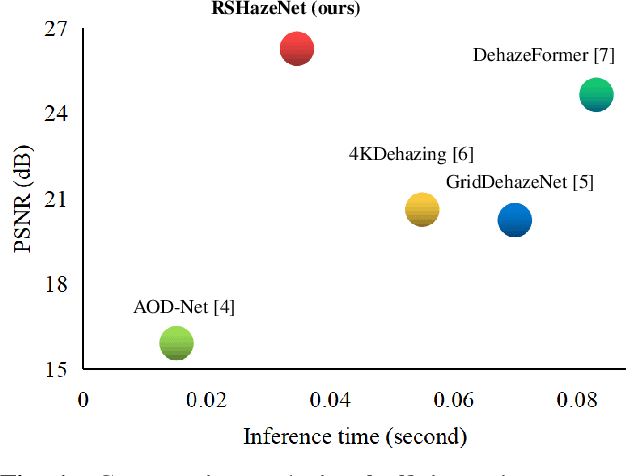

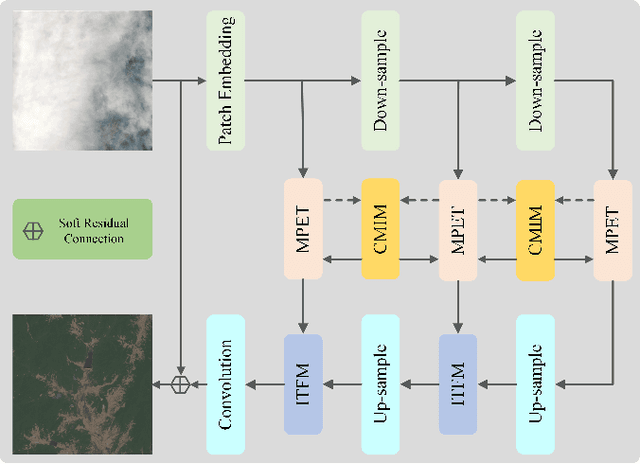
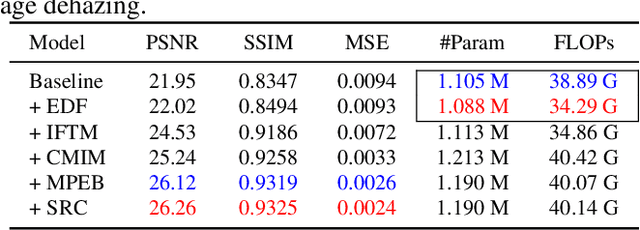
Abstract:Haze obscures remote sensing images, hindering valuable information extraction. To this end, we propose RSHazeNet, an encoder-minimal and decoder-minimal framework for efficient remote sensing image dehazing. Specifically, regarding the process of merging features within the same level, we develop an innovative module called intra-level transposed fusion module (ITFM). This module employs adaptive transposed self-attention to capture comprehensive context-aware information, facilitating the robust context-aware feature fusion. Meanwhile, we present a cross-level multi-view interaction module (CMIM) to enable effective interactions between features from various levels, mitigating the loss of information due to the repeated sampling operations. In addition, we propose a multi-view progressive extraction block (MPEB) that partitions the features into four distinct components and employs convolution with varying kernel sizes, groups, and dilation factors to facilitate view-progressive feature learning. Extensive experiments demonstrate the superiority of our proposed RSHazeNet. We release the source code and all pre-trained models at \url{https://github.com/chdwyb/RSHazeNet}.
GeoShapley: A Game Theory Approach to Measuring Spatial Effects in Machine Learning Models
Dec 06, 2023Abstract:This paper introduces GeoShapley, a game theory approach to measuring spatial effects in machine learning models. GeoShapley extends the Nobel Prize-winning Shapley value framework in game theory by conceptualizing location as a player in a model prediction game, which enables the quantification of the importance of location and the synergies between location and other features in a model. GeoShapley is a model-agnostic approach and can be applied to statistical or black-box machine learning models in various structures. The interpretation of GeoShapley is directly linked with spatially varying coefficient models for explaining spatial effects and additive models for explaining non-spatial effects. Using simulated data, GeoShapley values are validated against known data-generating processes and are used for cross-comparison of seven statistical and machine learning models. An empirical example of house price modeling is used to illustrate GeoShapley's utility and interpretation with real world data. The method is available as an open-source Python package named geoshapley.
 Add to Chrome
Add to Chrome Add to Firefox
Add to Firefox Add to Edge
Add to Edge